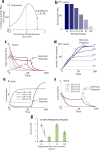Stability of Ensemble Models Predicts Productivity of Enzymatic Systems
- PMID: 26963521
- PMCID: PMC4786283
- DOI: 10.1371/journal.pcbi.1004800
Stability of Ensemble Models Predicts Productivity of Enzymatic Systems
Abstract
Stability in a metabolic system may not be obtained if incorrect amounts of enzymes are used. Without stability, some metabolites may accumulate or deplete leading to the irreversible loss of the desired operating point. Even if initial enzyme amounts achieve a stable steady state, changes in enzyme amount due to stochastic variations or environmental changes may move the system to the unstable region and lose the steady-state or quasi-steady-state flux. This situation is distinct from the phenomenon characterized by typical sensitivity analysis, which focuses on the smooth change before loss of stability. Here we show that metabolic networks differ significantly in their intrinsic ability to attain stability due to the network structure and kinetic forms, and that after achieving stability, some enzymes are prone to cause instability upon changes in enzyme amounts. We use Ensemble Modelling for Robustness Analysis (EMRA) to analyze stability in four cell-free enzymatic systems when enzyme amounts are changed. Loss of stability in continuous systems can lead to lower production even when the system is tested experimentally in batch experiments. The predictions of instability by EMRA are supported by the lower productivity in batch experimental tests. The EMRA method incorporates properties of network structure, including stoichiometry and kinetic form, but does not require specific parameter values of the enzymes.
Conflict of interest statement
The authors have declared that no competing interests exist.
Figures







References
-
- Rapp P. Oscillations and chaos in cellular metabolism and physiological systems. Chaos. 1986. pp. 179–203.
-
- Hess B, Boiteux a, Krüger J. Cooperation of glycolytic enzymes. Adv Enzyme Regul. 1969;7: 149–167. - PubMed
-
- Mees a I, Rapp PE. Periodic metabolic systems: oscillations in multiple-loop negative feedback biochemical control networks. J Math Biol. 1978;5: 99–114. - PubMed
-
- Fung E, Wong WW, Suen JK, Bulter T, Lee S-G, Liao JC. A synthetic gene–metabolic oscillator. Nature. 2005;435: 118–122. - PubMed
Publication types
MeSH terms
Substances
LinkOut - more resources
Full Text Sources
Other Literature Sources

